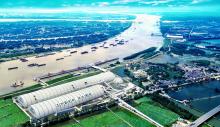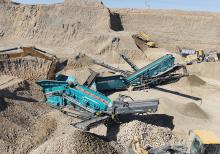The electric-powered loader loads blasted rock of varying size into the electric-powered hauler which, after a journey of around 30 metres down a well-maintained haul road, lowers the contents of the truck body into the electric-powered and noise reduction and dust suppression control-equipped primary crusher. Meanwhile, adjacent to the quarry, large fields full of different fruit trees and vegetable patches are being tended by several people, who politely nod in the direction of the latest guests checking into the neighbouring state-of-the-art eco-hotel. This is a snapshot of the eye-catching, grand government- and industry-backed vision for the future of the 20 billion tonnes-a-year aggregates industry in China. It is a vision that marries cutting-edge premium aggregates production equipment and technology with green building materials and eco-industrial park commerce.
The foundation for the major adoption of greener quarrying and linked environmental commerce and tourism has been laid by the Chinese government’s closure of tens of thousands of smaller environmentally harmful quarries across the vast country. This and a more diligent approach to granting new quarry licences, based on meeting tougher green production and site restoration criteria, has seen the number of Chinese quarries being reduced by around 40%, from more than 300,000 to 180,000. Most of those remaining are larger quarries which are already demonstrating or are willing to prove their commitment to more ecologically sustainable aggregates production.
Chinese aggregates demand currently accounts for 40% of the overall 50 billion annual global demand. But while national government investment in infrastructure projects, including the Belt and Road Initiative and the 24km, eight-lane Shenzhen-Zhongshan bridge near Hong Kong, coupled with the ongoing need to house 300 million people as part of continuing national urbanisation, is fuelling aggregates consumption, green quarrying and realising environmentally-minded commercial opportunities on land surrounding quarry sites has become president Xi Jinping’s government’s key focus for the national aggregates industry.
To help deliver a bold green quarrying revolution, the Chinese government is working closely with China Aggregates Association (CAA), the voice of the Chinese aggregates sector. This led to 10 national government departments jointly issuing on 4th November 2019 a document titled ‘Opinions on promoting the high-quality development of the manufactured aggregates industry’. As well as being China’s first official government guidance on the development of its aggregates sector, it was a rare example of a multi-government department promotion of a specific Chinese industry.
Many local Chinese authorities have also adopted CAA’s recommendations in a September 2018 letter outlining how best to safeguard aggregates provision and standardise the production process. Aggregates producers now must simultaneously complete re-habitation of their sites. Tighter controls have also been placed on the direct extraction of natural sandstone from China’s rivers and mountains.
The green quarrying revolution was the key theme of association president Hu Youyi’s keynote speech at the 6th International Aggregates Conference staged in Wuxi, a city of more than three-and-a-half million people and a major business hub around two hours’ drive north-west of Shanghai, eastern China.
Hu stressed that China’s five major future sources of aggregates would be natural sand and gravel mining (including river and fairway dredging); construction solid waste recycling; road and other engineering construction slag recycling; tailings and waste rock resources recycling; and primary mineral stone mine material. The manufactured aggregates processed by primary stone will be the main source of supply in the future.
Future quarries, said Hu, would have four development models: Aggregate 1.0 – green environmental protection aggregate plant; Aggregate 2.0 – extending the aggregate industrial chain; Aggregate 3.0 – green building materials industrial park; Aggregate 4.0 – eco-industrial park based on a quarry. Hu also noted that with the support of 5G technology, digital, unmanned quarries and smart mines in the aggregates industry will become a mainstream trend. The same technology will also see a rapid rise in the intelligent transportation of aggregates and the use of intelligent logistics.
“If we do not make these changes the Chinese aggregates industry will have very low efficiency,” said Hu during an interview with ABI after his keynote conference speech. “We want the industry to develop more inclusively rather than on traditional lines. This will benefit not only aggregates producers but also their surrounding communities. I want to help our industry reach a higher cultural level – that we share the same values as the people in the areas we work in. I also want our aggregates industry to learn from other industries; to adopt good ways of working and learn why other things did not work.”
Hu predicts that within five years more than 80% of Chinese quarries will reach the required green standard. “We will be helping quarries do this through our knowledge. We are also looking to cooperate with professional certification organisations so that quarry operators can receive official recognition for meeting a higher green standard.”
Flexibility is another key aspect of the Chinese green quarrying revolution, according to Hu. “All quarries are different. If a quarry and its surrounding area is big enough, you can look at introducing different elements, such as an eco-hotel. You also need to consider China’s varied climate. For example, in southern China where the weather is much warmer and wet, we can plant a lot of trees and plants to make the area around a quarry very beautiful.”
Hu stressed that many aggregates companies are already adhering to a higher standard of environmental protection than the government requires.
“We have visited other countries to learn about what they are doing around greener quarrying, and I have found that our values and practices in China appear to be at an advanced level. This is not just due to the size of our market.”
I asked Hu if there is a danger that increased aggregates production to meet rising Chinese infrastructure development need may harm attempts to fully implement the admirable national green quarrying plan.
“While aggregates demand linked to new infrastructure construction is very high, the speed of our quarry environmental restoration is also very high. China is renowned for its efficiency; our people are very hard-working. For example, we can dismantle a bridge and build another in one day. A 1,200-bed hospital in Beijing can be built in just one week, if demand dictates. We can balance a rise in production with the eco-quarrying plan.”
With its use of waterways to transport its aggregates products, use of production mud waste to create ceramics, electric-powered haul truck, the breeding of animals, such as chickens, to help feed employees, and the sensitive replanting of trees to allow for previously unworked areas of the site to be quarried, Xinkaiyuan quarry, in Huzhou, northern Zhejiang province, is an impressive current example of a Chinese green quarry. Speaking to ABI at the conference about the four million tonnes/year andesite aggregates production site in eastern China, Yao Yifan, chief engineer of Huzhou Xinkaiyuan Crushed Stone Co. Ltd, which operates the Xinkaiyuan quarry, said: “We have always paid a lot of attention to ecological protection.
Through support from the Chinese government and the China Aggregates Association, we have been able to develop our green quarry concept. In 2010, we were among the first batch of recognised green quarries in China.
“For me, there are several main aspects that make a green quarry. You need to make the best of your valuable mineral resources and not waste anything; you need to minimise the quarry’s impact on the environment and look to achieve zero emissions; and you need to know how to run the whole quarry in a good way, with a strong emphasis on product quality and added value. We can see at Xinkaiyuan quarry that after years of effort we can look around and see lots of wild animals and plants on site. We always wanted our quarry to resemble a beautiful garden.”
Song Shaomin, head of the CAA expert committee and professor of materials science at Beijing University of Civil Engineering and Architecture, also spoke to ABI during the conference. On the subject of China’s green quarrying revolution, he said: “Over the past 30 years China has developed very fast, but if we don’t change the way the aggregates industry works, it won’t be sustainable. High-quality aggregates are very important when it comes to ensuring the long life of buildings. Ensuring long life to buildings is the best way to achieve the biggest energy saving and emissions reduction. To achieve high-quality aggregates, you need to invest significantly in premium technology and equipment. China wants to express to the whole world how we pay close attention to the environment.”









